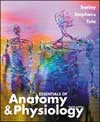 |  Essentials of Anatomy & Physiology, 4/e Rod R. Seeley,
Idaho State University
Philip Tate,
Phoenix College
Trent D. Stephens,
Idaho State University
Cell Structures and their Functions
Study OutlineFunctions of the CellClinical Focus: Relationships BetweenCellBasic unit of lifeStructure and Cell Function, p. 51
Protection and support
Movement
Communication
Cell metabolism and energy release
Inheritance
Cell Structure(Fig. 3.1, p. 43, Tbl. 3.1, p. 43)Cell membrane: Fluid Mosaic Model(Fig. 3.2, p. 44)Phospholipids
Proteins
Membrane channels
Carrier molecules
Receptor molecules: intercellular communication
Enzymes
Structural supports
Nucleus(Fig. 3.3, p. 45)Nuclear envelope
Chromatin and chromosomes
Nucleoli and Ribosomes(Fig. 3.4, p. 46)Formation of ribosomal subunits
Movement of ribosomes to cytoplasm
Rough and smooth ER(Fig. 3.5, p. 46)The Golgi apparatus(Fig. 3.6, p. 47)Secretory vesicles
Lysosomes
Peroxisomes
Mitochondria and oxidative metabolism(Fig. 3.7, p. 48)Cytoskeleton(Fig. 3.8, p. 49)Microtubules
Microfilaments
Intermediate filaments
Cilia, Flagella, and Microvilli
Whole cell activity
Movement through the Plasma Membrane(Table 3.2, p. 50)Selective permeability
Pathways of movement
Directly through phospholipid layers
Through membrane channels
Transported by carrier molecules
Transported within vesicles
Diffusion(Fig. 3.9, p. 50)Concentration gradient
Membrane channels
Osmosis(Fig 3.10, p. 52)Non-diffusible particles and osmotic pressure
Tonicity and solvent movement(Fig. 3.11, p. 54)Hypotonic solutions and lysis
Hypertonic solutions and crenation
Isotonic solutions
Filtration
Mediated Transport Mechanisms(Fig. 3.12, p. 54)Facilitated diffusion
Active transport(Fig. 3.13, p. 55)Secondary active transport(Fig. 3.14, p. 56)Endocytosis
Phagocytosis(Fig. 3.15, p. 56)Pinocytosis
Exocytosis(Fig. 3.16, p. 57) Cell Metabolism(Fig. 3.17, p. 57)Glycolysis
Aerobic respiration
Anaerobic respiration
Protein Synthesis(Fig. 3.18, p. 58)DNA
Transcription(Fig. 3.19, p. 59) Nuclear DNA
RNA synthesis
Translation(Fig. 3.20, p. 60)Ribosomes
mRNA
tRNA
Cell Division(Table 3.3, p. 65)Mitosis
Chromosomes
Replication - diploid daughter cells(Fig. 3.21, p. 61)Interphase - between cell divisions
Phases of mitosis(Fig. 3.22, p. 62)Prophase
Metaphase
Anaphase
Telophase
Meiosis
Haploid daughter cells-gametes
Phases of meiosis; two divisions(Fig. 3.23, p. 64)Interkinesis
Genetic diversity
Crossing over
Random distribution
Differentiation and DNA activity
Systems Pathology - Cystic FibrosisSystems Interactions Table, p. 67
|
|



 2002 McGraw-Hill Higher Education
2002 McGraw-Hill Higher Education